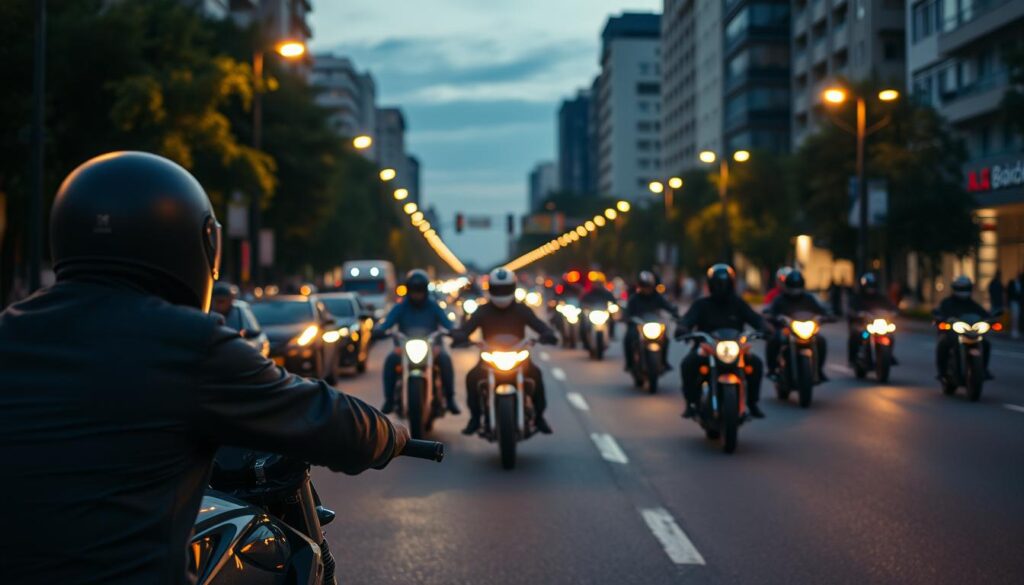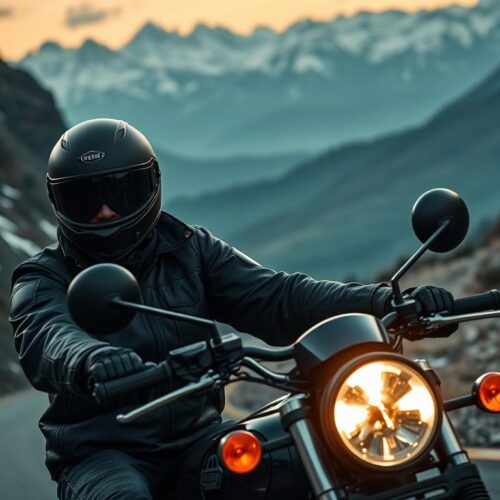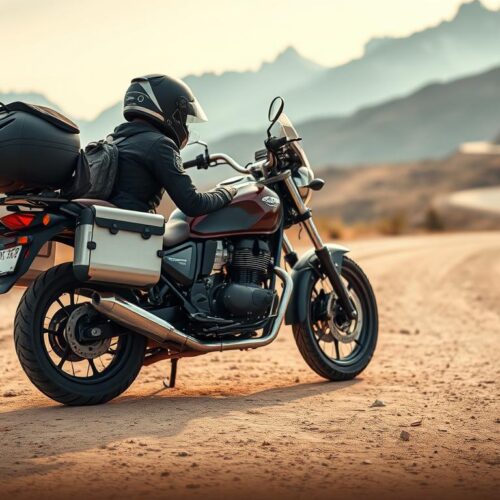Riding motorcycles with friends adds an exciting layer to the experience. It connects fellow enthusiasts. Yet, knowing group riding rules is key to safe fun. This guide shares vital tips for group motorcycle rides. It helps you ride with confidence and togetherness. Clear communication and rules boost safety and fun, making everyone feel important.
Understanding the Importance of Group Riding
Group riding brings many benefits, making rides safer and more fun. Riding with others builds a strong sense of community among bikers. It makes for memorable times. Swapping skills and tips with fellow riders helps you grow and improve. This makes each group ride a chance to learn something new.
There’s nothing like the excitement of exploring the open road with friends. Being in a group also makes you more noticeable to drivers, which is safer. By keeping an eye out for each other, you reduce risks and keep everyone safe. Showing respect for other riders makes group rides more enjoyable for everyone.
Preparing for a Group Ride
Getting ready for a group ride is key to having fun. Start by picking a meeting spot for everyone to gather. This keeps everyone on track. Think about the different skill levels when choosing the route. Some riders might not like twisty roads or fast highways. Talking about the ride plans in a group chat helps keep things clear.
Before you set off, make sure each rider has the right gear and tools. A checklist based on motorcycle manners can help make sure you don’t forget anything. For extra help, check out this comprehensive motorcycle trip preparation checklist.
Finally, go over the ride’s schedule with everyone. This makes sure all riders know what to expect. Using these tips will make the journey smoother and more fun for all.
Motorcycle Group Riding Formation
To ride safely in a group, it’s key to know the right formations. A group ride needs certain layouts to boost safety and keep order. For most group rides, the staggered formation is best. It lets riders spread out in the lane, switching between the left and right sides. This way, every rider can see ahead and have a way to dodge if needed.
When the road gets crammed or traffic thickens, switch to a single-file line. This approach cuts down the space each bike needs, making rides safer without losing touch with one another. Learning these formations helps riders grasp where they should be and how much space to leave.

| Formation Type | Best Used In | Benefits |
|---|---|---|
| Staggered | Open roads | Enhanced visibility, easier maneuverability |
| Single-File | Tight spaces, heavy traffic | Reduced width, increased safety |
Getting to know these formations and the rules of motorcycle group riding boosts your safety and your friends’. It makes riding together more fun, too.
Communication During a Group Ride
Effective communication is key for a safe and fun motorcycle group ride. Clear talking or signaling helps everyone stay in sync and avoids misunderstandings. Using hand signals is a direct way to show when you’re turning, stopping, or changing speed. This is especially useful since it’s hard to hear over the noise of the bikes.
Some riders prefer using Bluetooth devices for better connection. These devices let you talk in real-time, keeping you linked with your group. Agreeing on how to communicate beforehand makes rides smoother and safer for everyone.
- Use well-known hand signals for important actions.
- Make sure everyone knows how to use their Bluetooth device before starting.
- Have a way to point out dangers to others.
- Stay in touch with everyone, especially on long trips.
Following these guidelines can make your group rides much better. You’ll improve both safety and the feeling of togetherness among riders.
| Communication Method | Pros | Cons |
|---|---|---|
| Hand Signals | Simple & effective; requires no technology | Can be misinterpreted; visibility issues |
| Bluetooth Devices | Real-time communication; clearer intentions | Dependent on battery life; requires setup |
| Verbal Communication | Immediate feedback; can address complex situations | Noise interference; not suitable for high-speed environments |
Pre-Ride Checklist for Group Riders
Before a group ride, a detailed pre-ride checklist can make the journey safer and more fun. Start with key checks on every motorcycle. Look at tire pressure, test brakes, check all lights, and oil levels. These steps help avoid troubles during the ride.
Next, make sure motorcycle etiquette is followed by wearing the right safety gear. This means helmets, jackets, gloves, and boots. Also, bring tools and a first-aid kit for any road surprises. These actions show a serious approach to safety.
Being mentally ready is just as important. Urge everyone to rest well before the day to stay sharp and alert. Also, review the route with everyone ahead of time. This helps build readiness and unity, making the ride enjoyable for all.
Riding Etiquette and Rules
It’s vital to know and follow motorcycle etiquette during group rides. This makes sure everyone is safe and has fun. Don’t suddenly speed up or slow down. Keeping a steady speed that works for the group is best. Also, don’t ride too close to the person in front of you. This can lead to accidents.
Being polite on the road helps build friendship among riders. It’s important to think about what others in your group prefer and can do. Not everyone may like to ride fast or in the same way. Following group riding tips, like signaling when you’re going to change lanes or pointing out obstacles, makes for a nicer ride. Being aware of others helps everyone ride smoothly and trust each other more.

- Always wear protective gear to enhance safety.
- Signal all turns and lane changes clearly to let others know your intentions.
- Maintain a consistent speed, avoiding abrupt changes.
- Be mindful of your following distance to prevent collisions.
By sticking to these motorcycle etiquette rules and group riding tips, you’ll not only be safer. You’ll also make the ride more fun for everyone involved.
Navigating Intersections Safely
Intersections can be tricky for groups of riders and need careful attention to motorcycle etiquette. When you get to an intersection, it’s key to stay alert and keep your formation. The lead rider is very important for guiding the group safely through it.
The lead rider should signal which way they’re going early as you get closer. This gives everyone time to get ready for the turn. It makes moving through the intersection smoother and less confusing for the group.
If the group gets split up at an intersection, having a planned spot to meet again is crucial. Setting up these spots before hitting the road makes things less confusing. It keeps the group together. This planning makes riding together safer and more fun.
Emergency Procedures During Group Rides
It’s super important to plan for emergencies when you’re riding with a group. Knowing who does what is a key tip. Make sure someone is the sweep rider to help anyone who gets left behind or has trouble. This helps everyone feel looked after on the ride.
Knowing the rules for motorcycle group riding is also critical. Everyone should be clear on the plan, especially where to stop if something goes wrong. Good communication can really make a difference, keeping the group together and informed during surprises.
Being ready to handle medical issues can really reduce risks. Encourage each rider to bring a first-aid kit and know how to use it. This is super important for dealing with injuries or other emergencies that might happen.
Post-Ride Considerations
After your group ride ends, it’s key to have a post-ride debrief. This is a great time for everyone to talk about the ride. You can discuss what went well and what didn’t. These talks help build friendship and teach proper motorcycle manners. Sharing thoughts helps improve your skills and make future rides better.
It’s also crucial to check each motorcycle after riding. This ensures all bikes are safe and working right. Regular checks keep your bikes dependable. Skipping this step could cause bike problems later, affecting everyone’s ride.
Adding these steps to your routine is smart. It teaches motorcycle manners and gets your group ready for more rides. These tips can help make your next trip smoother and more fun. The experience improves when you dedicate time to reflect after riding.




